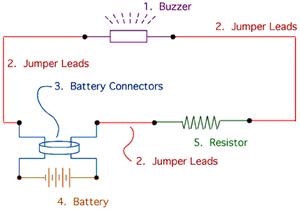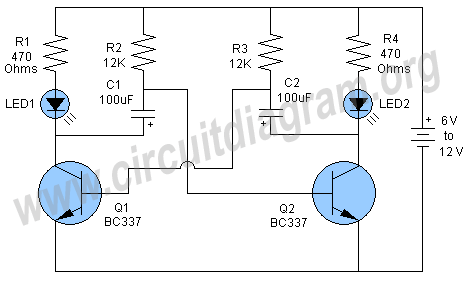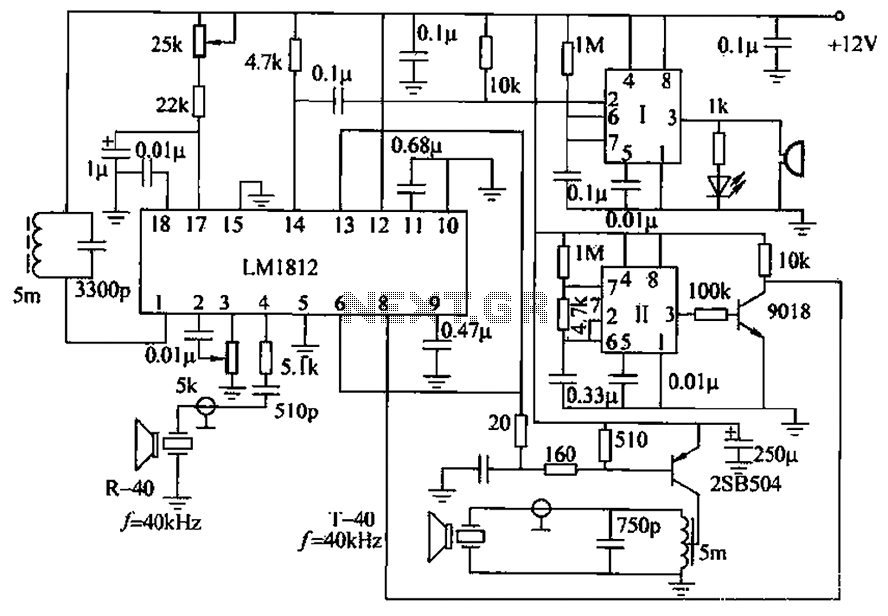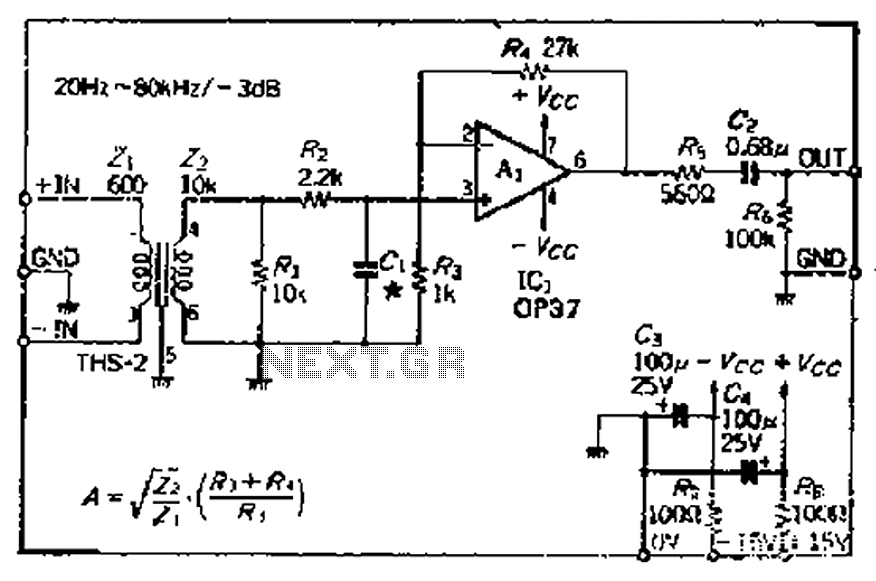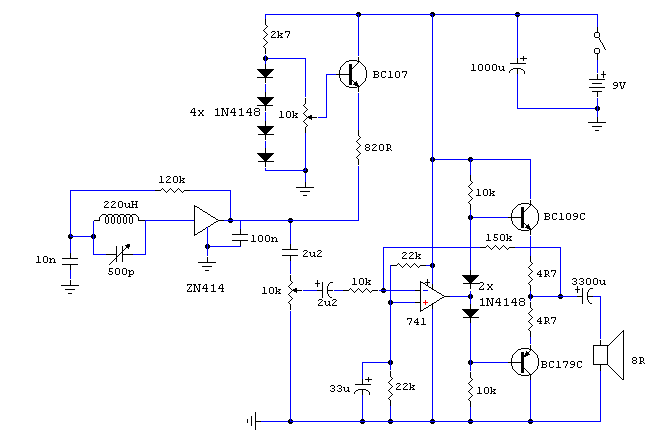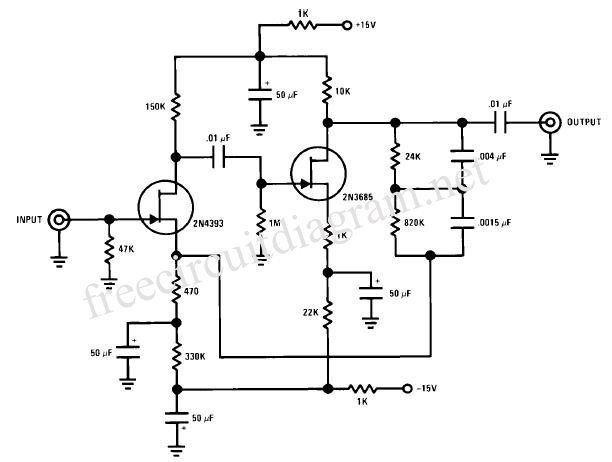
Circuit Compact DJ Station

This project involves a compact, portable DJ mixer that can be powered by a 9V DC external supply adapter or a 9V PP3 battery. The mixer includes two stereo phono inputs, two stereo line-level inputs, and a single stereo mixing channel. It also has a microphone input and a stereo main output with adjustable gain. Additionally, headphone monitoring features a cue switch for selecting Channel 1, Channel 2, or the Master Channel. The circuit is organized into five distinct blocks for clarity. The general circuit diagram shows all passive components, such as controls, faders, switches, and connectors, while active amplification modules are represented by labeled triangle symbols. The phono amplifier module is a high-gain stereo amplifier designed for moving magnet cartridges, featuring a frequency response that adheres to the RIAA equalization curve and utilizing the low noise, low distortion LS4558 dual IC. Two identical stereo modules are required for this setup. The headphone amplifier module, previously detailed on this website as a Portable 9V Headphone Amplifier, includes a low current drain stereo amplifier based on the low distortion, low noise 5532 dual IC. It can deliver 3.6V peak-to-peak into a 32-ohm load at 9V supply (equivalent to 50mW RMS) while maintaining less than 0.025% total harmonic distortion at 1kHz and 10kHz. Input sources can be selected using SW1 for Channel 1 and SW2 for Channel 2, with moving magnet pick-ups connected to Phono 1 and 2 inputs, and devices like CD players, iPods, and tape recorders connected to Line 1 and 2 inputs. Each channel has a separate level control (P1 and P2) that allows for mixing and cross-fading of the incoming audio signals through P3 and the associated resistor network. The crossfader control enables both channels to mix at equal intensity when centered. When P3 is fully rotated towards R3-R4, only Channel 1 is outputted, muting Channel 2, and vice versa when rotated towards R1-R2. Following this network is the mixer amplifier, the master level control (P4), and the main output sockets. A low impedance microphone can be connected to the mic input, with P6 controlling the signal level after amplification by the microphone amplifier module, feeding into the left and right mixer amplifiers via R9-R10, ensuring the speaker's voice is centered in the soundstage. A stereo headphone amplifier with cue gain control is provided for monitoring, with the cue select switch (SW3) allowing headphone reproduction of Channel 1, Channel 2, or the Master Channel independently from the main output signal. J13 serves as a mini DC power socket for the 9V DC external supply adapter. Due to the low total current drain (approximately 13mA average), a 9V battery is also a viable power source for the entire system. Using low tolerance components for R5, R6, R7, R14, R15, R16 (1%-2%) and C3, C4, C8, C9 (2%-5%) will yield a more accurate RIAA equalization curve.
The circuit design of the portable DJ mixer is structured to facilitate ease of use and flexibility in audio mixing. The two stereo phono inputs are intended for connecting turntables, while the stereo line-level inputs accommodate various audio sources, ensuring versatility in input options. The mixer’s architecture allows for seamless transitions between audio sources, making it ideal for live performances or studio settings.
The phono amplifier module plays a crucial role in ensuring high fidelity when using vinyl records, adhering to the RIAA equalization curve to provide accurate sound reproduction. The LS4558 dual IC is chosen for its low noise and distortion characteristics, making it suitable for high-quality audio applications.
The headphone amplifier module is designed to provide clear monitoring capabilities without significant power draw, allowing for extended use without rapid battery depletion. The 5532 dual IC is utilized for its ability to deliver substantial power while maintaining low distortion levels, critical for accurate monitoring during live mixing.
The mixing functionality, facilitated by the crossfader and independent level controls, allows the DJ to creatively blend audio signals. The design ensures that the audio signals can be manipulated intuitively, providing a dynamic mixing experience. The inclusion of a microphone input further enhances the mixer's capabilities, allowing for live vocal performances or announcements.
Overall, the portable DJ mixer is engineered for reliability and performance, with thoughtful consideration given to component selection and circuit design to meet the demands of both amateur and professional audio mixing applications.This project consists of a small, portable DJ mixer powered by a 9V dc external supply adaptor or from a 9V PP3 battery. The mixer features two stereo phono inputs and two stereo line-level inputs and has one stereo mixing channel.
A microphone input and a stereo main output with adjustable gain are also provided. Headphone monitoring includes a c ue switch for selecting Channel 1, Channel 2 or Master Channel. For easy understanding, the circuit is divided into five blocks, as follows: General Circuit diagram:all passive circuitry (controls, faders, switches, input and output connectors) is shown in full, whereas active amplification modules are represented by suitably labeled triangle symbols. Phono Amplifier Module: a high gain stereo amplifier suitable for moving magnet pick-up cartridges, having a frequency response according to RIAA equalization curve and based on the low noise, low distortion LS4558 dual IC.
Two identical stereo modules of this type are required. Headphone Amplifier Module: this circuit was already present on this website under Portable 9V Headphone Amplifier. It features a low current drain stereo amplifier based on the low distortion, low noise 5532 dual IC, capable of delivering 3.
6V peak-to-peak into 32 Ohm load at 9V supply (corresponding to 50mW RMS) with less than 0. 025% total harmonic distortion (1kHz & 10kHz). The input source can be selected by means of SW1 for Channel 1 and SW2 for Channel 2. Moving magnet pick-ups must be connected to Phono 1 and 2 inputs, whereas CD players, iPods, Tape recorders, PC Audio outputs and the like can be connected to Line 1 and 2 inputs. After a separate Level control for each channel (P1 and P2), the two incoming audio signals are mixed and cross-faded by means of P3 and associated resistors network.
The Crossfader control mixes both Channels at the same intensity when set in the middle position. When the cursor of P3 is fully rotated towards R3-R4, only Channel 1 signal is present at the Main output, whereas Channel 2 is muted. Conversely, Channel 2 signal is present at the Main output and Channel 1 is muted when the cursor of P3 is fully rotated towards R1-R2.
This network is followed by the Mixer Amplifier, the Master Level P4 and the Main output sockets. A low impedance microphone can be connected to the Mic input. P6 controls the signal level after amplification by the Microphone Amplifier module and feeds the Left and Right Mixer Amplifiers through R9-R10. In this way, the speakers voice will be reproduced at the center of the soundstage. A stereo Headphone Amplifier with cue gain control is provided for monitoring purposes. The Cue Select switch SW3 will allow Headphone reproduction of Channel 1, Channel 2 or Master Channel, independently of the signal present at the Main Output.
J13 is a Mini DC Power Socket into which the suitable plug of a 9V dc external supply adaptor should be inserted. In any case, due to the low total current drain (about 13mA average), a 9V battery can be used satisfactorily to power the entire Station.
A more strict RIAA equalization curve will be obtained if low tolerance components are used for R5, R6, R7, R14, R15, R16 (1% - 2%) and C3, C4, C8, C9 (2% - 5%). 🔗 External reference
The circuit design of the portable DJ mixer is structured to facilitate ease of use and flexibility in audio mixing. The two stereo phono inputs are intended for connecting turntables, while the stereo line-level inputs accommodate various audio sources, ensuring versatility in input options. The mixer’s architecture allows for seamless transitions between audio sources, making it ideal for live performances or studio settings.
The phono amplifier module plays a crucial role in ensuring high fidelity when using vinyl records, adhering to the RIAA equalization curve to provide accurate sound reproduction. The LS4558 dual IC is chosen for its low noise and distortion characteristics, making it suitable for high-quality audio applications.
The headphone amplifier module is designed to provide clear monitoring capabilities without significant power draw, allowing for extended use without rapid battery depletion. The 5532 dual IC is utilized for its ability to deliver substantial power while maintaining low distortion levels, critical for accurate monitoring during live mixing.
The mixing functionality, facilitated by the crossfader and independent level controls, allows the DJ to creatively blend audio signals. The design ensures that the audio signals can be manipulated intuitively, providing a dynamic mixing experience. The inclusion of a microphone input further enhances the mixer's capabilities, allowing for live vocal performances or announcements.
Overall, the portable DJ mixer is engineered for reliability and performance, with thoughtful consideration given to component selection and circuit design to meet the demands of both amateur and professional audio mixing applications.This project consists of a small, portable DJ mixer powered by a 9V dc external supply adaptor or from a 9V PP3 battery. The mixer features two stereo phono inputs and two stereo line-level inputs and has one stereo mixing channel.
A microphone input and a stereo main output with adjustable gain are also provided. Headphone monitoring includes a c ue switch for selecting Channel 1, Channel 2 or Master Channel. For easy understanding, the circuit is divided into five blocks, as follows: General Circuit diagram:all passive circuitry (controls, faders, switches, input and output connectors) is shown in full, whereas active amplification modules are represented by suitably labeled triangle symbols. Phono Amplifier Module: a high gain stereo amplifier suitable for moving magnet pick-up cartridges, having a frequency response according to RIAA equalization curve and based on the low noise, low distortion LS4558 dual IC.
Two identical stereo modules of this type are required. Headphone Amplifier Module: this circuit was already present on this website under Portable 9V Headphone Amplifier. It features a low current drain stereo amplifier based on the low distortion, low noise 5532 dual IC, capable of delivering 3.
6V peak-to-peak into 32 Ohm load at 9V supply (corresponding to 50mW RMS) with less than 0. 025% total harmonic distortion (1kHz & 10kHz). The input source can be selected by means of SW1 for Channel 1 and SW2 for Channel 2. Moving magnet pick-ups must be connected to Phono 1 and 2 inputs, whereas CD players, iPods, Tape recorders, PC Audio outputs and the like can be connected to Line 1 and 2 inputs. After a separate Level control for each channel (P1 and P2), the two incoming audio signals are mixed and cross-faded by means of P3 and associated resistors network.
The Crossfader control mixes both Channels at the same intensity when set in the middle position. When the cursor of P3 is fully rotated towards R3-R4, only Channel 1 signal is present at the Main output, whereas Channel 2 is muted. Conversely, Channel 2 signal is present at the Main output and Channel 1 is muted when the cursor of P3 is fully rotated towards R1-R2.
This network is followed by the Mixer Amplifier, the Master Level P4 and the Main output sockets. A low impedance microphone can be connected to the Mic input. P6 controls the signal level after amplification by the Microphone Amplifier module and feeds the Left and Right Mixer Amplifiers through R9-R10. In this way, the speakers voice will be reproduced at the center of the soundstage. A stereo Headphone Amplifier with cue gain control is provided for monitoring purposes. The Cue Select switch SW3 will allow Headphone reproduction of Channel 1, Channel 2 or Master Channel, independently of the signal present at the Main Output.
J13 is a Mini DC Power Socket into which the suitable plug of a 9V dc external supply adaptor should be inserted. In any case, due to the low total current drain (about 13mA average), a 9V battery can be used satisfactorily to power the entire Station.
A more strict RIAA equalization curve will be obtained if low tolerance components are used for R5, R6, R7, R14, R15, R16 (1% - 2%) and C3, C4, C8, C9 (2% - 5%). 🔗 External reference
